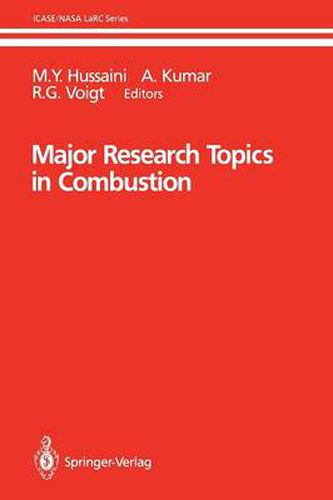Readings Newsletter
Become a Readings Member to make your shopping experience even easier.
Sign in or sign up for free!
You’re not far away from qualifying for FREE standard shipping within Australia
You’ve qualified for FREE standard shipping within Australia
The cart is loading…






This title is printed to order. This book may have been self-published. If so, we cannot guarantee the quality of the content. In the main most books will have gone through the editing process however some may not. We therefore suggest that you be aware of this before ordering this book. If in doubt check either the author or publisher’s details as we are unable to accept any returns unless they are faulty. Please contact us if you have any questions.
The Institute for Computer Applications in Science and Engineer ing (ICASE) and NASA Langley Research Center (LaRC) brought together on October 2-4, 1989 experts in the various areas of com bustion with a view to expose them to some combustion problems of technological interest to LaRC and possibly foster interaction with the academic community in these research areas. The top ics chosen for this purpose were flame structure, flame stability, flame holding/extinction, chemical kinetics, turbulence-kinetics in teraction, transition to detonation, and reacting free shear layers. The lead paper set the stage by discussing the status and issues of supersonic combustion relevant to scramjet engine. Then the ex perts were called upon i) to review the current status of knowledge in the aforementioned ;:I. reas, ii) to focus on how this knowledge can be extended and applied to high-speed combustion, and iii) to suggest future directions of research in these areas. Each topic was then dealt with in a position paper followed by formal discussion papers and a general discussion involving the participants. The position papers discussed the state-of-the-art with an emphasis on key issues that needed to be resolved in the near future. The discussion papers crit ically examined these issues and filled in any lacunae therein. The edited versions of the general discussions in the form of questions from the audience and answers from the speakers are included wher ever possible to give the reader the flavor of the lively interactions that took place.
$9.00 standard shipping within Australia
FREE standard shipping within Australia for orders over $100.00
Express & International shipping calculated at checkout
This title is printed to order. This book may have been self-published. If so, we cannot guarantee the quality of the content. In the main most books will have gone through the editing process however some may not. We therefore suggest that you be aware of this before ordering this book. If in doubt check either the author or publisher’s details as we are unable to accept any returns unless they are faulty. Please contact us if you have any questions.
The Institute for Computer Applications in Science and Engineer ing (ICASE) and NASA Langley Research Center (LaRC) brought together on October 2-4, 1989 experts in the various areas of com bustion with a view to expose them to some combustion problems of technological interest to LaRC and possibly foster interaction with the academic community in these research areas. The top ics chosen for this purpose were flame structure, flame stability, flame holding/extinction, chemical kinetics, turbulence-kinetics in teraction, transition to detonation, and reacting free shear layers. The lead paper set the stage by discussing the status and issues of supersonic combustion relevant to scramjet engine. Then the ex perts were called upon i) to review the current status of knowledge in the aforementioned ;:I. reas, ii) to focus on how this knowledge can be extended and applied to high-speed combustion, and iii) to suggest future directions of research in these areas. Each topic was then dealt with in a position paper followed by formal discussion papers and a general discussion involving the participants. The position papers discussed the state-of-the-art with an emphasis on key issues that needed to be resolved in the near future. The discussion papers crit ically examined these issues and filled in any lacunae therein. The edited versions of the general discussions in the form of questions from the audience and answers from the speakers are included wher ever possible to give the reader the flavor of the lively interactions that took place.